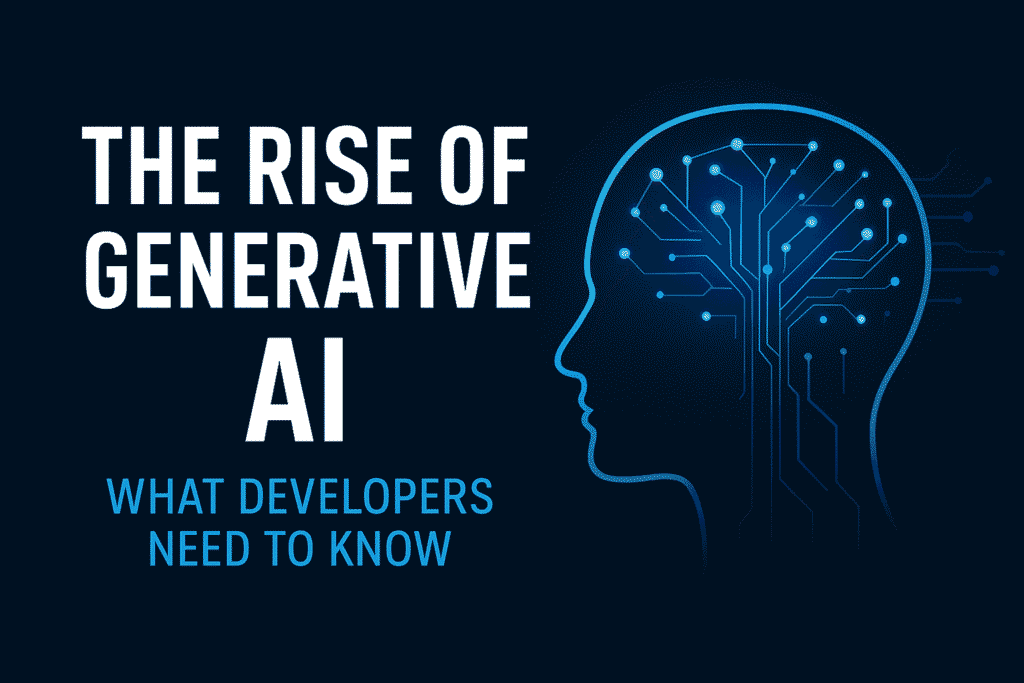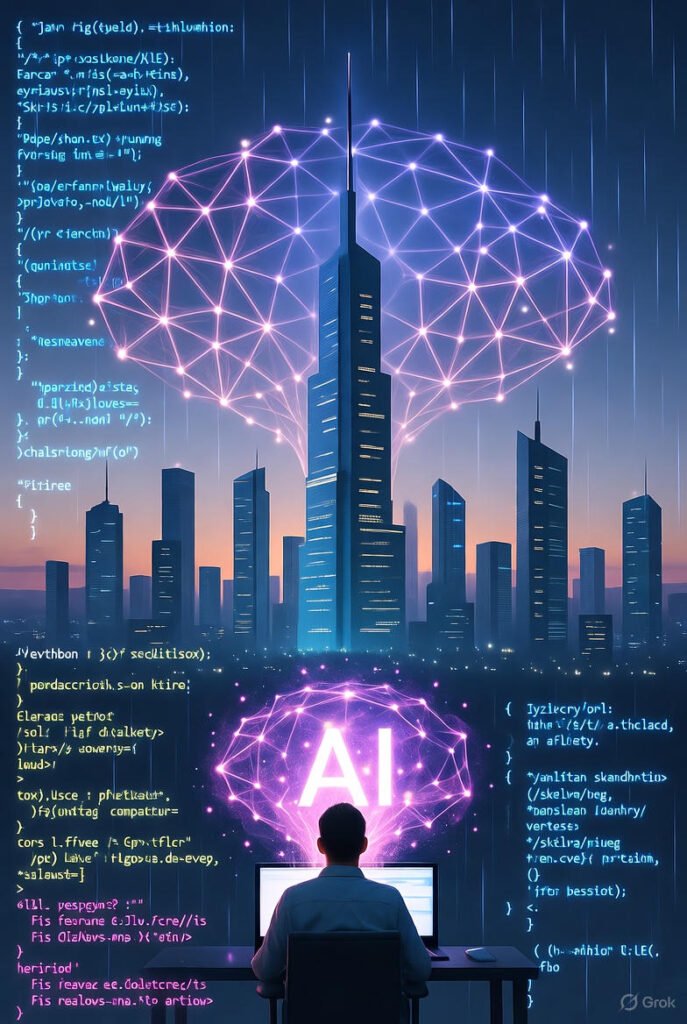
Introduction
Generative AI is no longer just a buzzword—it’s reshaping the way we think about software development, content creation, and problem-solving. From creating images, code, and music to generating human-like text, this branch of artificial intelligence is moving fast and opening doors that developers never imagined.
For developers, understanding generative AI isn’t just a nice-to-have skill—it’s becoming essential. Whether you’re building applications, automating workflows, or exploring AI-driven products, knowing how generative AI works and how to implement it effectively can set you apart in a competitive landscape.
In this article, we’ll explore what generative AI is, why it matters for developers, practical applications, challenges, and tips to leverage it effectively.
1. What is Generative AI?
Generative AI refers to algorithms that can create new content based on existing data. Unlike traditional AI, which mainly identifies patterns or predicts outcomes, generative AI can produce something entirely new—whether it’s text, images, music, or even code.
Key Concepts
- Machine Learning Models: Most generative AI relies on deep learning architectures like transformers, GANs (Generative Adversarial Networks), and VAEs (Variational Autoencoders).
- Training Data: Generative AI models learn from massive datasets, which help them understand context, style, and structure.
- Output: The result is often human-like and can be customized according to prompts or input data.
Example:
- OpenAI’s ChatGPT generates text-based content.
- DALL·E creates images from textual descriptions.
- Copilot by GitHub writes code snippets based on developer prompts.
2. Why Generative AI Matters to Developers
Generative AI isn’t just about cool demos—it’s transforming real-world software development. Here’s why developers should care:
2.1 Accelerating Development
- AI-powered coding assistants like GitHub Copilot reduce boilerplate coding time.
- Generate documentation, test cases, or repetitive functions automatically.
2.2 Enhancing Creativity
- Developers can experiment with new ideas quickly.
- Prototype designs, UI mockups, or even generate API responses without manual effort.
2.3 Automating Content-Heavy Tasks
- Generate reports, email content, or templates for apps automatically.
- Useful for startups or teams with limited resources to maintain high-quality outputs.
2.4 Staying Competitive
- Generative AI skills are becoming a requirement in AI-driven startups and enterprises.
- Being proficient allows developers to create AI-integrated products that offer unique user experiences.
3. Practical Applications of Generative AI for Developers
Generative AI can be applied across multiple domains. Here are some practical examples developers can implement today:
3.1 Code Generation and Assistance
- GitHub Copilot: Autocompletes code snippets.
- TabNine: Offers AI-based code suggestions for multiple languages.
- Benefits:
- Reduce coding time
- Maintain coding consistency
- Minimize syntax errors
3.2 Automated Testing
- Generate test cases automatically using AI models.
- Predict potential edge cases that developers might overlook.
- Tools: Diffblue Cover, AI-powered testing scripts.
3.3 Natural Language Interfaces
- Build chatbots, virtual assistants, or customer service solutions using OpenAI GPT models.
- Convert natural language queries into structured code or database commands.
3.4 Content and Media Generation
- Generate images: DALL·E, MidJourney, or Stable Diffusion.
- Generate audio or music: Jukebox by OpenAI or AI-driven audio synthesizers.
- Useful for apps, games, and marketing content without relying on external creators.
3.5 Data Augmentation
- Expand datasets for machine learning with synthetic data.
- Helps improve model performance without needing extensive real-world data collection.
4. Challenges Developers Should Know
While generative AI is exciting, it comes with challenges:
4.1 Ethical Concerns
- AI-generated content can be biased based on training data.
- Deepfakes and misleading content pose ethical and legal risks.
4.2 Model Limitations
- AI output may sometimes be inaccurate or inconsistent.
- Developers need to validate AI-generated code, content, or designs.
4.3 Computational Resources
- Generative AI models are resource-intensive, requiring GPUs or cloud-based solutions.
- Cost and infrastructure planning is essential.
4.4 Data Privacy
- Sensitive data used for training can pose security risks.
- Implement anonymization and follow data regulations like GDPR or CCPA.
5. Tips for Developers Using Generative AI
Here are actionable insights to make your generative AI journey more effective:

5.1 Start Small
- Begin with specific use cases like code completion, chatbots, or image generation.
- Experiment with pre-trained APIs before building custom models.
5.2 Validate Everything
- Always verify AI outputs.
- Use unit tests for generated code and human review for generated content.
5.3 Optimize Prompts
- AI models respond differently depending on prompts.
- Use clear, context-rich prompts for more accurate outputs.
5.4 Combine with Existing Tools
- Integrate AI outputs into CI/CD pipelines.
- Use AI suggestions alongside linters, IDEs, and existing development frameworks.
5.5 Keep Learning
- Generative AI is evolving rapidly.
- Follow research papers, GitHub repositories, and AI communities to stay updated.
6. Future Trends for Developers
The future of generative AI promises even more opportunities:
6.1 AI-Generated Applications
- Entire apps may be prototyped or generated by AI, reducing time-to-market.
6.2 Multi-Modal AI
- Models combining text, images, audio, and code in one pipeline.
- Example: GPT-4 and beyond supporting multi-modal prompts.
6.3 Collaboration Between Human and AI
- AI acts as a co-developer rather than a replacement.
- Teams will use AI for brainstorming, prototyping, and testing at unprecedented speeds.
6.4 Personalized Developer Tools
- IDEs and productivity tools powered by AI that adapt to individual coding styles.
7. Getting Started with Generative AI as a Developer
Here’s a roadmap to integrate generative AI into your workflow:
- Choose Your Platform: Start with OpenAI, Hugging Face, or Cohere for APIs.
- Identify Use Cases: Pick areas like code completion, content generation, or testing.
- Experiment with Pre-Trained Models: Avoid building everything from scratch.
- Monitor and Evaluate: Track accuracy, reliability, and resource consumption.
- Iterate and Scale: Gradually integrate AI into production pipelines.
Conclusion
Generative AI is no longer a futuristic concept—it’s a developer’s essential tool. From automating code and generating content to creating innovative applications, the possibilities are endless.
For developers, the key is to start experimenting, validate outputs, and integrate AI thoughtfully into workflows. By embracing generative AI now, developers can accelerate productivity, unleash creativity, and stay competitive in a rapidly evolving tech landscape.
The rise of generative AI isn’t just a trend—it’s the next evolution of development, and understanding it today is crucial for building the software of tomorrow.